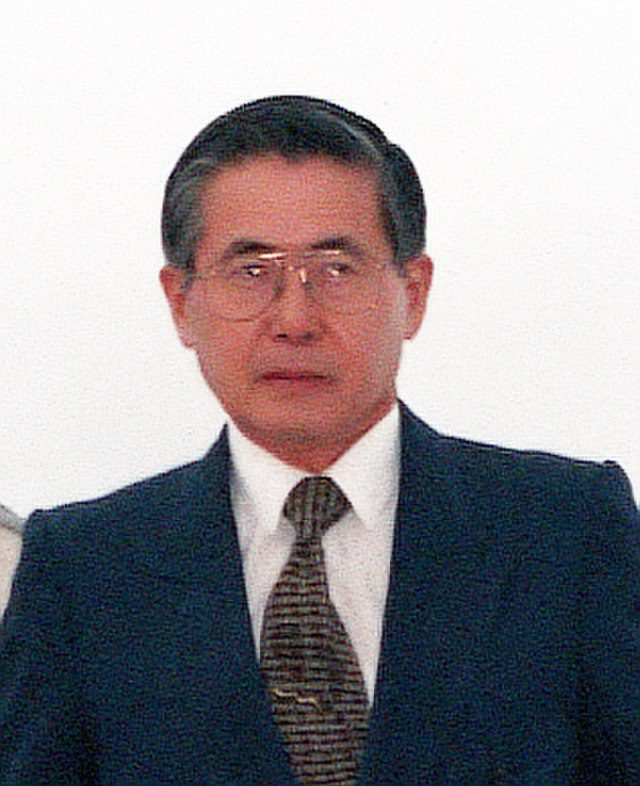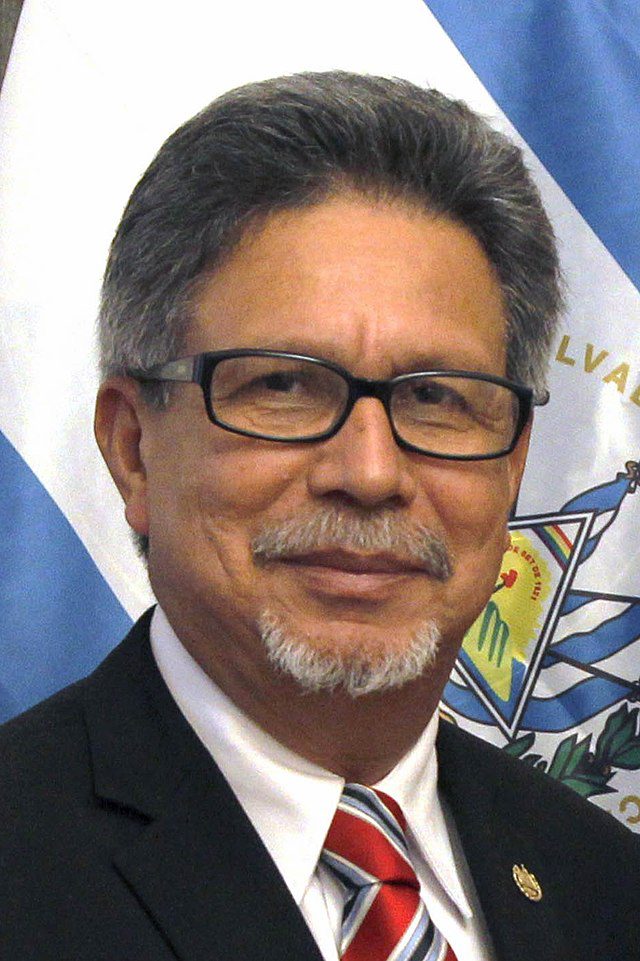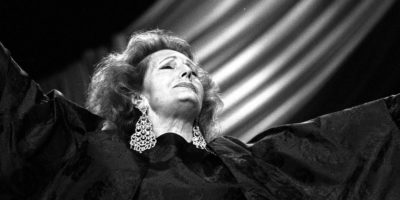15 Most Famous People from Peru
*Originally published by Nellian on October 2022 , Updated by Vanessa R in August 2023 and Updated by Felix in February 2024
1. Claudio Pizarro
2. Isabel Allende
3. Carlos Castaneda
4. Alberto Fujimori

Alberto Fujimori by Karen L. Sanders from Wikimedia Commons
5. César Vallejo
6. Yma Súmac

Yma Súmac by an Unknown author from Wikimedia Commons
7. Paolo Guerrero
8. Rose of Lima
9. Alan García

Alan García by Peru’s Ministry of Foreign Affairs from Wikimedia Commons
10. Henry Ian Cusick
11. Alejandro Toledo

Marcello Casal Jr./ABr, CC BY 3.0 BR, via Wikimedia Commons
12. Alex Acuña
Music has a significant impact on many countries, including Peru. A skilled drummer, he has developed his own unique style since he was a young child. He made a major contribution to the local music scene in the 1960s and gained widespread recognition through his collaboration with Perez Prado, known as the King of the Mambo. Without a doubt, he was a well-travelled musician who performed alongside some of the most iconic names in music history. Acuna’s talent shone through as he provided the perfect rhythm for every act he supported.
He played behind legends such as Paul McCartney from The Beatles and Elvis Presley, as well as soul music icons like Diana Ross and Ella Fitzgerald. His versatility also allowed him to collaborate with renowned artists like U2, Carlos Santana, Whitney Houston and other R&B greats. Acuna’s performances were not confined to any particular genre or artistic movement, but rather, he adapted to the beat of whoever he was playing for. His power on stage was truly transcendent.
13. Carlos I. Noriega
Many notable Peruvians have made their mark in places far from their homeland. However, besides Carlos I. Noriega, we are not aware of anyone else who has accomplished this feat. Noriega is best known for his space travel and astronaut work. He was a previous NASA employee who made important contributions to the study of the universe.
He was born in Lima, Peru in 1959 and lived there with his family until the age of five, before moving to California. Although he made his biggest impact at NASA in the United States, he still brings attention to his Peruvian roots while being a US citizen. Children in Peru and other countries look up to him as a role model.
14. María Julia Mantilla
Peru has also positioned itself in the world of beauty pageants. Maria Julia Mantilla made her home nation proud on the biggest possible scale. She started out locally, taking first place in the Miss La Libertad pageant. She then went on to win Miss Peru.
In 2004, she participated in the Miss World competition and showcased her remarkable talents. She received the majority of votes through phone and online and won the crown of Miss World that year. This brought her global recognition and appreciation from all corners of the world. Mantilla is a successful actress and model with other career achievements to her name. She made a state visit in 200.
15. Claudia Llosa
Perhaps you’ve seen her on-screen receiving more media attention due to her efforts. You may have even witnessed her in her breakthrough role on the big screen in the Spanish film La Teta Asustada, which was titled The Milk of Sorrow in English. The film garnered much praise and received an Oscar nomination. It was put forward for consideration for the award.
It was been forward for the award for best foreign film. She keeps up her steady employment, gaining recognition for each skillfully performed role. Watch for Claudia Llosa’s name to appear in upcoming films and other ventures. She is a fantastic actor with a lot of success ahead of her, as her fans in Peru and beyond would confirm.
Top 20 Facts about Peruvian People
Let me take you on a fascinating journey into the heart of Peru and its vibrant people. As a country nestled in the Andes Mountains of South America, Peru boasts a rich tapestry of cultural heritage, woven over centuries. From ancient civilizations like the Incas to the modern-day fusion of Indigenous, Spanish, and Afro-Peruvian influences, the Peruvian people are as diverse as the landscapes that stretch across their land. Picture yourself wandering through bustling markets filled with colorful textiles, savoring the tantalizing flavors of ceviche and pisco, or dancing to the rhythmic beats of traditional music.
Beyond the surface, there’s so much more to discover about this captivating culture. Did you know that Peru is home to Machu Picchu? Or that the potato, a humble staple in diets worldwide, originated in the Andean highlands of Peru? Join me as we delve into captivating facts about the Peruvian people, from their deep-rooted connection to nature to their passionate love for soccer. Get ready to be amazed by the warmth, resilience, and boundless creativity of the Peruvian spirit.
These are twenty facts about the Peruvian people:
1. Peruvians have Three Officially Recognized Languages
Just like many other countries, Peru is a multilingual country, with Spanish, Quechua, and Aymara as its three officially recognized languages. Spanish is spoken by more than half of the population, imposed on the indigenous peoples during the Spanish conquest in the sixteenth century. Quechua was the language of the Inca Empire. Aymara is the third official language and is spoken by people in the Lake Titicaca region and other parts of southern Peru. These three languages highlight Peru’s diverse cultural heritage, stemming from both Spanish colonization and its indigenous roots.
2. There are just above Thirty Million Peruvians
With a total population of around thirty-three million people, Peru is the fourth most populous country in South America. The latest census data indicates that Peru’s population crossed the thirty million mark in 2017 when the number of inhabitants reached 30,381,884. This reflects steady population growth over the past decades, as Peru’s population stood at around twelve million in 1950. The population is concentrated mainly along the coast and in the Andean highlands, while the Amazon rainforest region remains more sparsely inhabited. With its youthful population and continued urbanization, Peru’s population is projected to grow to over forty million by 2050.
3. Some Peruvians Live on floating Islands made of Grass
In the high altitude Lake Titicaca along the border of Peru and Bolivia dwell the Uros people, an indigenous group who construct remarkable floating islands made entirely of totora reeds. These dense beds of reeds are layered with mud and roots to form artificial islands strong enough to live on. The Uros people harvest and replenish the reeds constantly to maintain the buoyancy and size of their man-made floating islands. About a thousand Uros people inhabit this unique lake environment, building reed houses and boats, and living largely self-sufficient lives closely tied to the lake and its resources. The floating islands provide secure dwellings and enable the Uros to maintain their threatened indigenous identity.
4. They are Renown Food Enthusiasts who make good Food

David Berkowitz from New York, NY, USA, CC BY 2.0, via Wikimedia Commons
Peruvian cuisine has gained global recognition in recent decades for its vibrant flavors and diversity of ingredients. With influences from indigenous cultures, Spanish colonizers, and Japanese/Chinese immigrants, Peruvian food embraces a rich culinary history. Peruvians take great pride in their cuisine and are known as food enthusiasts eager to share their love for iconic dishes like ceviche, lomo saltado, and ají de gallina. The Andean, Amazonian, and Pacific ingredients and cooking techniques produce complex flavors that make Peruvian gastronomy popular worldwide. From humble street food to high-end restaurants, Peruvians dedicate immense care to preparing and presenting unforgettable meals that reflect their cuisine’s esteemed status.
5. Peruvians enjoy a range of Forty Four locally spoken Languages
Peru is home to a remarkable diversity of indigenous languages, with forty-four still spoken within its borders today. These originate from several different language families, including Quechuan, Aymaran, and the many diverse tongues of the Amazon rainforest. From the high Andes to the Amazon basin, Peru’s native peoples maintain their ancestral languages as vital parts of their cultural identity. This linguistic diversity is a source of pride for Peruvians, representing their rich cultural heritage stemming from pre-Columbian civilizations as well as more recent indigenous groups.
6. Peruvian embrace diverse Cultural Heritage

Congreso de la República del Perú from Lima, Perú, CC BY 2.0, via Wikimedia Commons
Here, the culture is shaped by a confluence of Indigenous, Spanish, and Afro-Peruvian traditions. Indigenous heritage is seen in textiles, music, and Quechua/Aymara languages still spoken by many. Spanish influence arrived in the sixteenth century through conquest and colonization, leaving a legacy in religion, arts, and architecture. African culture was imported by Spanish enslavers and had an impact through artistic expressions like dance, percussion, and cuisines like Lima’s hearty Criollo cooking. Today, Peru takes pride in its diverse population and cultural fusion. Traditions like Andean weaving and Afro-Peruvian folk music coexist and intermix.
7. Ceviche is a popular Peruvian dish depicting their love for fresh Seafood
Ceviche is Peru’s national dish and a shining example of the country’s passion for ultra-fresh seafood. The raw fish marinated in citrus juice embodies the coastal spirit of Lima and Peruvian cuisine. The instant lime-cooking of tender white fish alongside fiery rocoto chiles, sweet onions, and nutty toasted corn captures Peru’s zesty flavors. Ceviche vendors freshly prepare each batch to order, showcasing the daily catch. Fish markets bustle as chefs meticulously select their seafood starting at dawn. Ceviche’s immediacy requires this devotion to freshness. Peruvians will travel far and wide for the perfect ceviche, exemplifying their discerning obsession with seafood at its freshest and most vibrant.
8. Machu Picchu stands as an Iconic Symbol of Ancient Incan Civilization

Pedro Szekely at https://www.flickr.com/photos/pedrosz/, CC BY-SA 2.0, via Wikimedia Commons
The magnificent ruins of Machu Picchu perched high in the Peruvian Andes serve as an enduring emblem of the Inca Empire. Constructed in the fifteenth century, this citadel was built with immense precision from polished stones without mortar. The exact purpose of Machu Picchu remains shrouded in mystery. Its sophisticated architecture incorporating temples, plazas, and astronomy exemplifies Incan design, hydraulics, and spirituality. Since its rediscovery in 1911, Machu Picchu has captivated the world as a stunning relic of pre-Columbian America. As Peru’s most famous attraction, visited by over a million people annually, Machu Picchu is an iconic monument to the ingenuity of the Incan civilization.
9. Peruvians celebrate Inti Raymi, a festival honoring the Sun god Inti
Inti Raymi is an ancient Inca religious ceremony celebrated on the June solstice to venerate Inti, the sun god in Inca mythology. This colorful festival continues today as an important part of Peru’s living indigenous traditions. People gather in Cusco’s main plaza where actors reenact ancient rites like the symbolic harvesting of corn as offerings to Inti. Dancers in resplendent costumes representing Inca rulers and the sun itself perform to the rhythm of drums and pan flutes. At the climax, a fire ceremony begins as handmade torches light up the night sky. Inti Raymi honors Peru’s indigenous roots.
10. Their Andean Condor holds Cultural significance as a Symbol of Power

Michael Gäbler, CC BY 3.0, via Wikimedia Commons
Soaring high above the Andes, the majestic Andean condor holds an esteemed place in Peruvian culture as a symbol of strength and power. With a huge ten-foot wingspan, this revered bird has been an important icon for Andean peoples since pre-Inca times. Ancient myths bestowed sacred status on the condor, believing it delivered messages between worlds. Today, Peruvians proudly depict the Andean condor on coins, stamps, and the national coat of arms as an embodiment of authority. Seeing the endangered condor take flight over the rugged landscape continues to evoke pride and wonder, reaffirming Peru’s enduring connection to this avian king of the Andes.
11. Peruvian make Textiles with intricate Designs and vibrant Colors
Peruvian textile traditions date back thousands of years and continue to thrive today. Ancient Andean weaving developed stunningly complex techniques and motifs. Garments were markers of social status, conveyed through elaborate geometric patterns and vivid natural dyes. Coastal communities like Pisco create finely woven cotton to showcase Peru’s diversity. Highland villages weave sheep wool adorned with symmetrical designs honoring Inca heritage. Peru’s worldwide fame for quality textiles draws on both indigenous mastery and continuous innovation. For Peruvians, weavings represent community identity and pride in refined craftsmanship that imparts gorgeous, intricate artistry into every fiber.
12. Pisco, a Grape Brandy is a cherished National Spirit in Peru

ollie harridge, CC BY 2.0, via Wikimedia Commons
Pisco, the aromatic grape brandy of Peru, holds a beloved status as the country’s national libation. Produced since the sixteenth century, pure pisco uses only the muscat grapes grown in Peru’s coastal valleys. Distillation concentrates the fruity aromas and flavors to create a bold, yet smooth spirit. Pisco occupies a central role in Peruvian drinking culture, adding a patriotic flair to cocktails like the Pisco Sour or Chilcano. Bars proudly showcase an array of local piscos. More than just an alcoholic drink, pisco represents Peru’s viticulture heritage and ability to transform grape nectar into a distinctive liquor of refined character and complex bouquet.
13. Many Peruvians speak the Quechua language
Quechua, the most widely spoken indigenous language amongst Peruvians, traces its origins to the Inca Empire where it was the official language. When the Spanish arrived in the 1500s, Quechua usage persisted and expanded as local tongues blended into today’s Quechua variants. Millions still speak the living legacy of this ancient tongue from Cusco to Lima to rural Andean villages. Quechua carries an extensive oral tradition and reflects how Peruvian indigenous identity endured despite repression. Even as globalization threatens indigenous languages, Quechua remains a vibrant part of Peru’s cultural heritage. Its endurance celebrates the continuity between Peru’s pre-Colombian civilizations and the proud syncretism of Incan and Hispanic cultures.
14. Peruvian music encompasses diverse genres

Dennis Jarvis from Halifax, Canada, CC BY-SA 2.0, via Wikimedia Commons
Peru’s music scene thrives with different rhythms that combine indigenous, African, and European influences. On the coast, Marinera fuses African and Spanish styles into elegant couples’ courtship dances. In the Andean highlands, the lively pulse of Huayno mixes native wind and percussion instruments for festivals and celebrations. Global trends like rock, pop, and reggaeton now enjoy local followings. Through innovation and cultural blending, Peru’s musical landscape retains its diversity. Traditional tunes play on alongside new fusions, underscoring Peru’s rich heritage and creative spirit. This mosaic of genres expresses the country’s storied roots and dynamic future.
15. They discovered Potato cultivation
The potato’s origins trace back to Peru, where Inca farmers domesticated wild tubers into the staple crop we know today. Peru’s varied mountainous regions allowed thousands of colorful, tasty potato types to evolve over centuries. The Inca cultivated over two hundred varieties, of freeze-drying potatoes for storage. When the Spanish arrived, they exported this nutritious crop worldwide. Peru still boasts thousands of potato types, more than anywhere globally. Annual festivals like La Paucartambo celebrate the potato’s diversity and importance for Andean cuisine and agriculture. From purple to yellow, fingerling to oval, Peru’s iconic potato diversity showcases ingenious indigenous cultivation and centuries of passionate potato pride.
16. The Amazon Rainforest is Home to many Indigenous Tribes in Peru

Neil Palmer/CIAT, CC BY-SA 2.0, via Wikimedia Commons
The vast Peruvian Amazon, covering over half the country’s territory, has been inhabited for millennia by diverse indigenous peoples adapted to the lush jungle environment. Groups like the Asháninka hunt, fish, and cultivate gardens rich in manioc and plantains. Machiguenga build thatched homes in the jungle canopy, while ribereños live along the snaking rivers. Though threatened by development, tribal identities persist through language, ritual, cuisine, music, and more. From scattered settlements to uncontacted bands deep in the rainforest, Peru’s native Amazonians represent the human pulse of the jungle and the continuation of ancient ways of life.
17. Peru’s National Soccer Team garners widespread support and passion
Though not on Brazil and Argentina’s level, soccer permeates Peruvian culture, uniting the nation in spirited support of the cherished national team. Fans fill stadiums, crowd around radios, and fly flags when the red-and-white takes the field. Star players like Teófilo Cubillas, current captain Paolo Guerrero, and the iconic Peru Cueva embody the squad’s rich history and talent. Though La Blanquirroja has endured heartbreaks and championship droughts, optimism always returns. Qualifying for Russia 2018 after a thirty-six-year World Cup absence sparked massive celebrations. Whether singing the Solitaria fan anthem or cheering acrobatic goals, Peruvian soccer loyalty persists through ups and downs.
18. The Potato, Quinoa, and Maize are staples in Peruvian Cuisine

Image by Christos Giakkas from Pixabay
Andean crops like the potato, quinoa, and maize have sustained Peruvian cuisine for millennia. Cultivated by indigenous civilizations and spreading worldwide, these foods hold iconic status. The humble potato originated in Peru. Quinoa, once called “the mother grain” by the Inca, makes nutritious soups and sides. Maize, transformed into choclo corn or moraya beer, brings starch and sweetness. Today these ancient foods grace both high-end and home-cooked Peruvian meals. More than sustenance, the potato, quinoa, and maize represent cultural endurance, biodiversity, and the roots of Peru’s treasured culinary traditions. Their prominent role reveals Peru’s enduring bond with its cherished Andean ingredients.
19. Peruvian Folklore is rich with Mythical Beings
Peru’s vibrant folkloric tradition abounds with supernatural creatures that reveal insights into indigenous beliefs. The shape-shifting Chullachaqui tricks travelers in the jungle, often appearing as a loved one. Pishtacos are said to roam Andean roads seeking fat from lone travelers. The Inkarrí myth tells of an Inca king’s spirit protecting ancient ruins. Sirenas with long black hair are said to lure men to the lake depths. These beings create cautionary tales and explain the unknown. Shared through songs, stories, and art, they inspire imagination and transmit cultural values. From rural villages to urban centers, mythic beings like these persist in Peru’s living folklore as remnants of indigenous cosmology, enriching national identity.
20. Peruvians honor their Ancestors through Rituals and Ceremonies

Image by inno kurnia from Pixabay
Lastly, ancestor veneration has deep roots in Peru, with many rituals continuing to honor those who came before. Offerings like flowers and food are left at cemeteries during Día de los Muertos to welcome visiting spirits. In Andean villages, dancing troupes like the Confradía de Negritos channel the dead through colorful costumes and masks. During the Q’oyllur R’iti pilgrimage, dancers perform for Apus, mountain gods representing ancestors. Candles are lit on Christmas and All Saints Day for cherished relatives who have passed. The living and dead communicate in a reciprocal exchange through these ceremonies.
The Peruvian people embody a rich tapestry of culture, history, and traditions that captivate the imagination. From ancient civilizations to modern-day innovations, their resilience and creativity shine through. Let’s celebrate the diverse and vibrant spirit of Peru and continue to explore its wonders.
Planning a trip to Paris ? Get ready !
These are Amazon’s best-selling travel products that you may need for coming to Paris.
Bookstore
- The best travel book : Rick Steves – Paris 2023 – Learn more here
- Fodor’s Paris 2024 – Learn more here
Travel Gear
- Venture Pal Lightweight Backpack – Learn more here
- Samsonite Winfield 2 28″ Luggage – Learn more here
- Swig Savvy’s Stainless Steel Insulated Water Bottle – Learn more here
Check Amazon’s best-seller list for the most popular travel accessories. We sometimes read this list just to find out what new travel products people are buying.

 English
English











